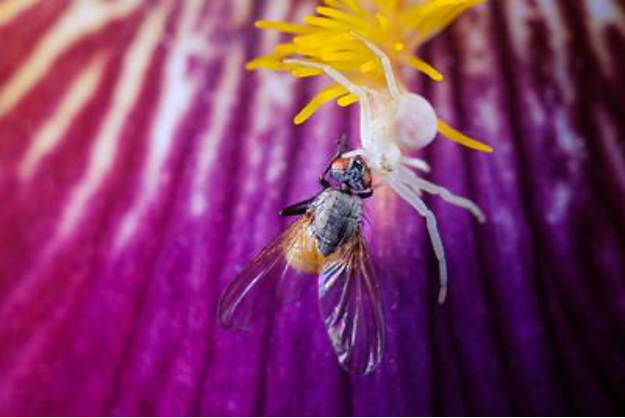Garden of Weavin’: The Benefits of Garden Spiders
go.ncsu.edu/readext?940017
en Español / em Português
El inglés es el idioma de control de esta página. En la medida en que haya algún conflicto entre la traducción al inglés y la traducción, el inglés prevalece.
Al hacer clic en el enlace de traducción se activa un servicio de traducción gratuito para convertir la página al español. Al igual que con cualquier traducción por Internet, la conversión no es sensible al contexto y puede que no traduzca el texto en su significado original. NC State Extension no garantiza la exactitud del texto traducido. Por favor, tenga en cuenta que algunas aplicaciones y/o servicios pueden no funcionar como se espera cuando se traducen.
Português
Inglês é o idioma de controle desta página. Na medida que haja algum conflito entre o texto original em Inglês e a tradução, o Inglês prevalece.
Ao clicar no link de tradução, um serviço gratuito de tradução será ativado para converter a página para o Português. Como em qualquer tradução pela internet, a conversão não é sensivel ao contexto e pode não ocorrer a tradução para o significado orginal. O serviço de Extensão da Carolina do Norte (NC State Extension) não garante a exatidão do texto traduzido. Por favor, observe que algumas funções ou serviços podem não funcionar como esperado após a tradução.
English
English is the controlling language of this page. To the extent there is any conflict between the English text and the translation, English controls.
Clicking on the translation link activates a free translation service to convert the page to Spanish. As with any Internet translation, the conversion is not context-sensitive and may not translate the text to its original meaning. NC State Extension does not guarantee the accuracy of the translated text. Please note that some applications and/or services may not function as expected when translated.
Collapse ▲The showy black and yellow bodies of Argiope aurantia are hard to miss once they make their appearance. More commonly known as the black and yellow garden spider or writing spider, they can be found throughout the state of NC and other portions of the United States. However, they are not the only spider that can be found wandering around your yard and garden during the summer and fall. There are many different species of spiders that live in the environments around us.
The spiders around you are a misunderstood group of animals that are actually beneficial. They eat pests that would otherwise be attacking your garden and yard like aphids, grasshoppers, caterpillars, thrips, and more. Because they aren’t picky about what types of insects they consume, they may eat bugs that are actually there to help pollinate your plants. Despite this, it is best to leave them alone as they eat far more nuisance insects than helpful ones. Spiders themselves act as a source of food for birds that are also likely to help get rid of pests too.
Grass Spiders
This group of spiders make themselves at home on lawns, around the bottoms of buildings, and short shrubs. They make thick, flat webs that are funnel shaped. Grass spiders hide in their funnels, waiting for prey to make contact with their webs. They come rushing out once they sense a meal. Their coloration can be described as a mix of brown and gray.
Wolf Spiders
Large and hairy, these types of spiders can be found wandering around during the day or night. They like to chase after their prey and aren’t known to construct webs. However, they may still have a structure made of their silk that they reside in. Wolf spiders look like mini tarantulas with brown or gray bodies with white markings.
Crab Spiders
Crab spiders gain their other name, flower spiders, due to where they are often found. They can be found sitting in flowers with their giant forelegs. Their remaining

Crab Spider
four hind legs are much smaller. They lie in wait for their prey to ambush them when they come flying in. This type of spider also doesn’t spin webs and is active during the day time.
Jumping Spiders
As their name suggests, they are known for their ability to jump, incredibly more than 40 times their own body length. They don’t make webs and can be rather dull colored or iridescent. Jumping spiders instead stalk their prey and pounce on it. These spiders are typically about medium in size and are known to act a bit twitchy.
Harvestmen
Well known as Daddy long legs, these arachnids aren’t actually spiders. They enjoy hanging out in groups so seeing several of them together is common. Harvestmen lack fangs, cannot bite, and are able to eat solid food. They only have two eyes, one body section instead of two like spiders, and are brown, gray, yellow, or red.
These active arachnids are sure to help keep your garden pest free. Let them assist you in your endeavors to grow crops by leaving them in peace. Refrain from squishing them and performing pesticides applications for spiders. You and your plants will certainly be thankful that you didn’t.
References
Spiders are a Gardeners Friend
Common Spiders in North Carolina
Zaria Reep is a Summer Intern from NC State for North Carolina Cooperative Extension in Lee County.




